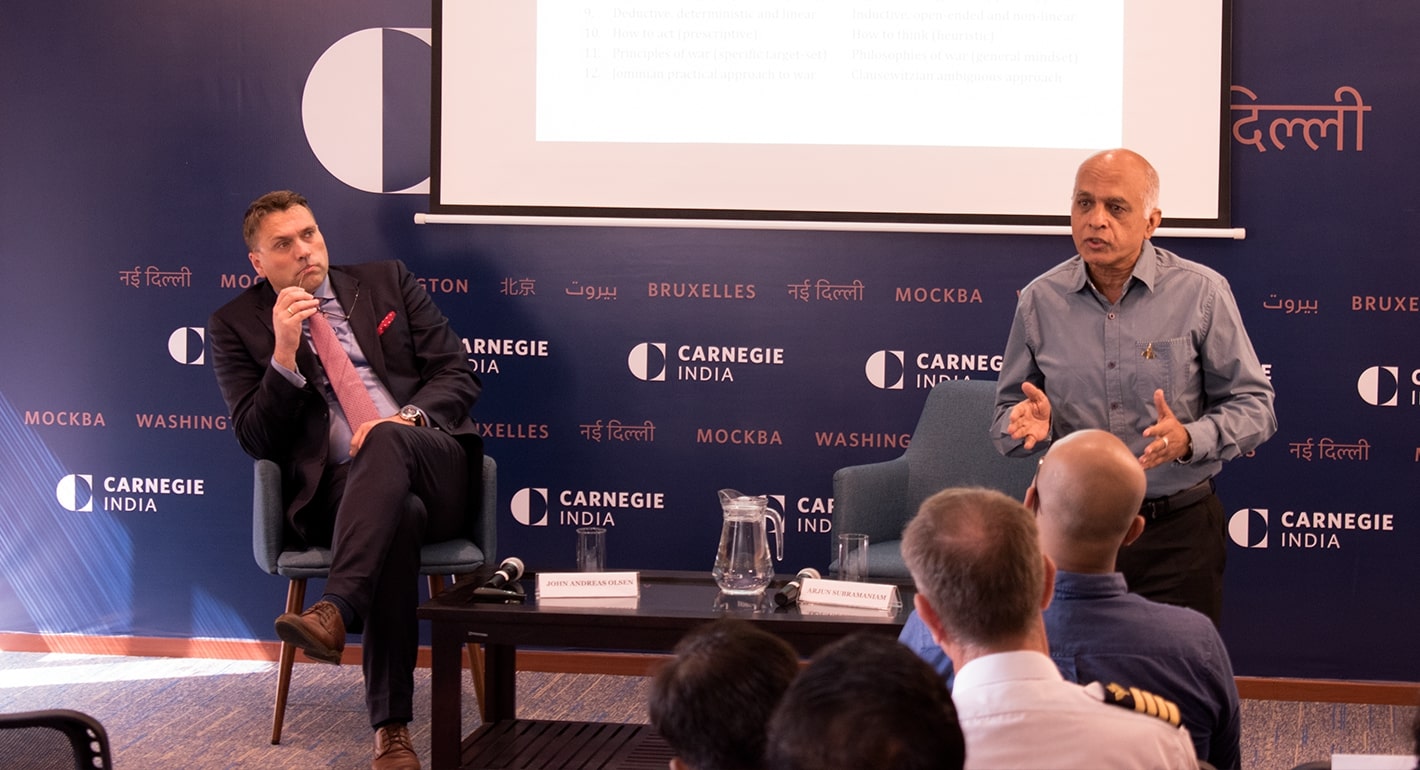Registration
You will receive an email confirming your registration.
IMGXYZ8441IMGZYX
KnowledgeTransfer@CarnegieIndia is an initiative that aims to provide a platform to facilitate the genuine exchange of ideas and knowledge among students, practitioners, subject-matter experts, and other interested audiences.
The advent of air power has significantly altered the nature of warfare. In the words of the political scientist Eliot A. Cohen, air power offered states the unique advantage of “gratification without commitment,” wherein the speed and agility of the air forces could be leveraged to strike an enemy at lesser risk of being hit compared to territorial and naval armies. Even with the development of anti-aircraft technology, and maxims like “no war was won by airpower alone,” instances like the Persian Gulf War of 1991 demonstrated the effectiveness of air power and the advantages that belligerents can reap through its use. Ever since its first major foray into warfare during World War I, air power has undergone a significant military-technological revolution, with implications for strategic theory that underpins the application airpower. How have these changes impacted the way in which leaders employ air power? What does the future hold for the theory and practice of air power?
Carnegie India hosted John Andreas Olsen, defense attaché at the Embassy of Norway in London, and Arjun Subramaniam, visiting professor of international relations at Ashoka University, for a KnowledgeTransfer@CarnegieIndia workshop on “Air Power: Theory and Practice.”
Discussion Highlights
- Evolution of Air Power Theory: Participants noted that the evolution of air power could be categorized into three phases. The first phase was characterized by the thinking of early air power theorists who advocated strategic bombardment aimed at targeting the enemy’s source of power, as opposed to deploying air power for providing support to ground-based operations by the army. In the second phase, air power came to acquire the nuclear dimension, with the air force delivering nuclear warheads. The third phase in the evolution of air power theory was influenced by the works of John A. Warden and John Boyd. While the former suggested targeting the enemy leadership to paralyze their fighting force and physically debilitate them, the latter advocates a rapid series of surprise attacks at the tactical level to hurt enemy morale and psychologically incapacitate them.
- Challenges to Air Power: Participants analyzed the challenges that hinder the development and effective employment of air power today. They mentioned that a singular focus on ground warfare and a general inclination to invade and control land in current military strategy pose hurdles to a greater utilization of air power in war. However, participants disagreed on the strategic utility of air power. Some participants pointed to the potential for escalation that air power can cause and expressed concern that it may lead to the situation spiraling out of control. Contrarily, others argued that, when appropriately used, air power can actually de-escalate the situation. They highlighted the example of Operation White Sea during the Kargil crisis between India and Pakistan and explained that the Indian air force had successfully expelled regular and irregular Pakistani troops from the region, thereby leading India toward victory. Participants also called for more intellectual debates within the armed forces to foster a better understanding of the importance of air power in military strategy.
- Future of Air Power: Participants deliberated on how leaders might employ air power in the future for military and political ends. By invoking Clausewitz’s credo of war being an extension of politics, participants recognized that while air power could be used for solely military purposes, it can potentially serve the political end of signaling military strength, agility, and superiority to the adversary. They mentioned that in the past, military strategists had heightened expectations of what air power could achieve if employed effectively, leading many to levy criticism when its application didn’t yield the expected results. Furthermore, they also mentioned that persistence in thinking of air power as an extension of land-based military strategies has led to conceiving a predominantly limited, tactical role for air force in battle. They emphasized the need to connect air power with “strategic effect” and “national policy” by thinking more creatively about its deployment in war and rethinking our expectations of what air power can achieve.
This event summary was prepared by Suchet Vir Singh, a research intern at Carnegie India.
John Andreas Olsen
John Andreas Olsen is a colonel in the Royal Norwegian Air Force, currently assigned to London as defense attaché to the United Kingdom and Ireland. He is also a non-resident senior fellow of the Mitchell Institute of Aerospace Studies. Olsen has lectured worldwide, received several awards, and published a series of books on airpower theory, including Airpower Reborn: The Strategic Concepts of John Warden and John Boyd (Naval Institute Press, 2015), and most recently, The Routledge Handbook of Air Power (Routledge, 2018). His books on airpower appear on the professional reading lists of the Royal Air Force, Royal Australian Air Force, Royal Netherlands Air Force, and the U.S. Air Force. Previously, he was the director of security analyses in the Norwegian Ministry of Defence and deputy commander and chief of the North Atlantic Treaty Organization (NATO) Advisory Team at NATO Headquarters, Sarajevo. He was a visiting professor at the Swedish Defence University from 2018 to 2018.
Arjun Subramaniam
Arjun Subramaniam is a fighter pilot-scholar who retired as an air vice marshall from the Indian Air Force in 2017, after 36 years in uniform. He holds a PhD in Defence and Strategic Studies from the University of Madras, India. A prolific writer, strategic commentator, and military historian, he is the author of three books, including the hugely popular India’s Wars: A Military History 1947-1971 (2016). He is currently a visiting professor of international relations at Ashoka University.
